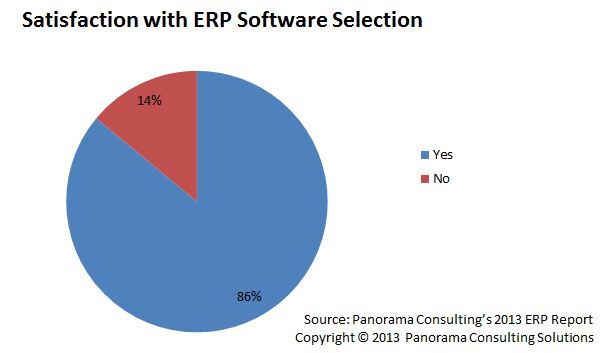One of the interesting takeaways from our 2013 ERP Report released earlier this year is the apparent confusion between the perceived success and actual results of ERP implementations. While most ERP projects still take longer than expected, cost more than expected and fail to deliver expected business benefits, our research indicates that most organizations are still generally satisfied with their ERP implementations.

This begs the question: how can companies experience such dismal implementation results yet still feel a sense of success at the end of the day? Our experience with hundreds of ERP implementations over the years suggests that there are a number of reasons for this dichotomy. First and foremost, most organizations don’t have a clear definition of success. Assuming the new ERP system provides at least an incremental improvement to their business operations, chances are that executives and employees are going to feel at least somewhat satisfied with their ERP system once the transition pains have subsided.
Below are three things that will help you and your project team achieve ERP success:
1. Clearly define success. We hear it all the time: for some organizations, anything is better than the ERP system they currently have in place. However, most organizations also aren’t spending millions of dollars on new ERP software just to realize an incremental improvement. Instead, most are looking for a tangible return on the investment in that software, just as they would expect from an investment in an acquisition or any other major capital investment. The problem is that executives generally don’t clearly articulate to the organization what exactly they expect from the new ERP system and how they will determine whether or not the implementation is ultimately successful. The business case should be an important mechanism to not only justify the investment in the ERP system but also to define what will constitute ERP success.
2. Articulate expected process improvements. Similarly, expected business process improvements should be clearly defined and articulated to the organization. It’s not enough to simply suggest that the software is going to make business processes better. Those process improvements should be clearly defined and documented for employees so they can enable some of the process improvements. Your people – not the ERP software – will ultimately determine whether or not the process improvements stick, so rather than assume people won’t revert back to their inefficient manual processes and spreadsheets, it is much more effective to define the expected business processes and communicate changes to employees accordingly. This will also make your organizational change management activities much more effective in the long-run.
3. Conduct post-implementation audits. Even in a perfect world, measurable business goals and process improvements aren’t going to happen overnight. Beginning 60 to 90 days after implementation, your team should conduct a post-implementation audit to ensure that actual results are measured and compared to expected business benefits. In addition, these audits identify where process improvements are breaking down or presenting additional opportunities for improvement. Although it can be a harrowing exercise since it will inevitably reveal organizational issues and business process deficiencies, it is an important way to identify and correct root causes for the benefit shortcomings. Typically, these audits will reveal low-hanging fruit that can be remediated with relatively simple prescriptions, such as refresher training or tweaks to business processes or software configuration. After spending millions of dollars on an ERP implementation, these investments in post-implementation optimization are relatively immaterial in the grand scheme of things.
Post-implementation is arguably the thing that organizations struggle with the most during their ERP implementations, which is a key reason why so many implementations fail to deliver expected business benefits. In fact, most project teams are so relieved to finally finish their ERP implementations that they never get to the post-implementation audit phase, but it’s nearly impossible to optimize business benefits without doing so.
Learn more by downloading our white paper, Ten Tips for a Successful ERP Implementation.













